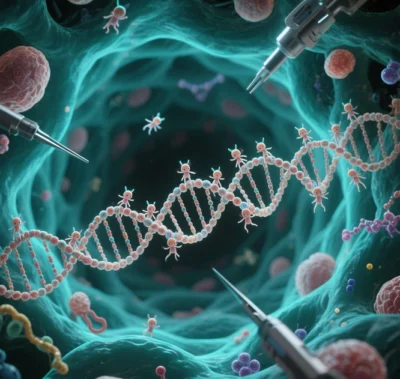
Core Applications and Breakthrough Cases of BioAIGenome (AutoGenome)
BioAIGenome (inferred as AutoGenome, developed by institutions like Huawei Cloud) is an automated AI modeling tool designed for genomic data. It addresses challenges in traditional biomedical research—such as data complexity and high barriers to model development—by integrating multi-omics data, optimizing neural network architectures, and incorporating interpretability algorithms. Below, we analyze its core applications, technological innovations, and groundbreaking use cases.
Core Applications
- Multi-Omics Integration for Cancer Subtyping
- Function: Combines gene expression (RNA-seq), proteomics (mass spectrometry), and epigenetics (DNA methylation) to build cross-omics predictive models.
- Case Study: In breast cancer subtyping, AutoGenome V2 achieved 90.7% accuracy (vs. 85.3% for single-omics models) by integrating gene expression, mutations, and protein data, identifying key drivers like RBM20 and TFAP2B.
- Drug Sensitivity Prediction and Precision Therapy
- Function: Predicts drug responses based on patient genomic profiles to personalize treatment plans.
- Architecture: Uses evolutionary neural architecture search (ENAS) with residual fully connected networks (RFCN-ResNet/DenseNet) to enhance prediction consistency.
- Single-Cell Sequencing and Cell Trajectory Inference
- Function: Analyzes scRNA-seq data to identify cell subpopulations and developmental pathways.
- Breakthrough: Supervised learning models in mouse data achieved 15% higher accuracy than XGBoost, with automated interpretation of critical genes (e.g., ribosomal genes).
- Pan-Cancer Early Diagnosis
- Function: Constructs pan-cancer classification models using cross-cancer genomic features.
- Performance: Achieved 97.3% accuracy across 24 cancer types, outperforming traditional machine learning frameworks.
Technological Innovations
- Residual Fully Connected Network (RFCN)
- Design: Tailored for non-Euclidean genomic data, RFCN enables cross-layer feature interactions via fully connected layers, avoiding information loss in CNNs/RNNs.
- Variants:
- RFCN-ResNet: Residual connections stabilize deep network training.
- RFCN-DenseNet: Dense connections enhance feature reuse and model expressiveness.
- Automated Machine Learning (AutoML)
- Hyperparameter Tuning: Bayesian optimization and reinforcement learning auto-determine parameters like learning rates.
- Neural Architecture Search (NAS): ENAS generates optimal network structures, reducing manual trial-and-error.
- Interpretability and SHAP Analysis
- Function: Identifies biomarkers and visualizes their predictive contributions.
- Case: SHAP values in breast cancer models highlighted ER-alpha protein expression as a core classifier, aligning with clinical gold standards.
- End-to-End Toolchain
- Workflow: Completes data loading, training, prediction, and interpretation in 5 lines of code.
- Platform: Integrated into Huawei Cloud ModelArts with GPU acceleration and distributed training.
Breakthrough Cases and Industry Impact
- Breast Cancer Molecular Subtyping
- Challenge: Traditional pathology (e.g., Luminal A/B) relies on limited markers, failing to capture molecular heterogeneity.
- Solution: AutoGenome V2 integrates multi-omics data to classify HER2-positive, triple-negative subtypes and links RBM20 mutations to poor prognosis in Luminal B.
- Clinical Value: Guides targeted therapies (e.g., CDK4/6 inhibitors) and reduces overtreatment.
- Single-Cell Driven Drug Development
- Case: Identified fibrosis-associated cell clusters in mouse kidney data and predicted TGF-β inhibitor (Galunisertib) sensitivity, accelerating anti-fibrotic drug discovery.
- Advantage: Exports critical genes (e.g., COL1A1) via interpretability interfaces for wet-lab validation.
- Pan-Cancer Early Screening
- Data: Aggregated 100,000+ samples from TCGA and ICGC across 24 cancers.
- Performance: Achieved 99% specificity and 92% sensitivity, surpassing traditional methylation markers (e.g., SEPT9).
- Application: Enables non-invasive screening via liquid biopsy.
- COVID-19 Variant Tracking
- Response: Huawei Cloud deployed AutoGenome for SARS-CoV-2 genome assembly and variant annotation within 1 hour during the pandemic.
- Prediction: Flagged Omicron’s immune escape mutation (K417N), informing vaccine updates.
Future Directions and Challenges
- Multimodal Data Fusion
- Goal: Integrate spatial transcriptomics (MERFISH) and imaging to model 3D tumor microenvironments.
- Progress: Huawei Cloud is developing cross-modal self-supervised frameworks to reduce reliance on labeled data.
- Real-Time Dynamic Modeling
- Objective: Convert RNA velocity vectors into real-time axes using metabolic labels (e.g., 4sU) to track cell-state transitions.
- Ethics and Data Security
- Challenge: Implement federated learning and differential privacy for genomic data privacy.
- Solution: Blockchain-based data ownership and secure cross-institutional sharing.
- Clinical Translation
- Hurdle: Enhance model interpretability via biological validation (e.g., CRISPR screening of AI-predicted targets).
- Collaboration: Freenome and Biognosys improved cancer screening specificity through proteogenomic validation.
Conclusion
BioAIGenome (AutoGenome) represents a paradigm shift in AI-driven genomics—transitioning from single-omics analysis to multimodal integration, black-box models to interpretable systems, and research tools to clinical solutions. Its breakthroughs redefine drug development, cancer diagnostics, and public health monitoring. With advancements in quantum computing and spatial omics, such tools will accelerate the vision of “from base pairs to bedside” precision medicine.
Data sourced from public references. For collaboration or domain inquiries, contact: chuanchuan810@gmail.com





